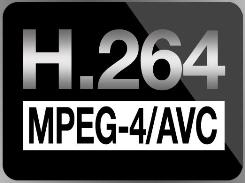How has H.264 video compression changed
the CCTV game?

Imagine the life of a security guard in the 70’s. Back then no one had ever heard of flash cards or even digital cameras. Instead, you had to handle all the footages on VHS videotapes. Clumsy, robust and fragile. Storage and archiving were a pain in the neck. Still, back then, believe it or not, it was the top of the line.
Well, not anymore. During the last 40 years history has changed the game a great deal. Standards were introduced and soon considered outdated. And now? Is the landscape somewhat clearer? Let’s check it out.
Dynamism – that is a characteristic of digital video technology
CCTV is a highly dynamic market. When H.264 was standardised in 2003, a lot of manufacturers started manufacturing their systems compatible with H.264. Most cameras you get in the market are H.264 but when you decide to have a high resolution camera, you also have to make sure your DVR fits into the system. But…
What is video compression?
Video compression refers to compressing the video data to a digital format. Digital is preferred over analogue in video transmission due to its stability and reliability.
Storing digital images is one of the major challenges CCTV systems face. Compressing the video and audio data is meant to help easy storage, easy video transmission through IP and many more.
This technique is used widely in CCTV systems; however, every coin has two sides: when video is compressed it is more likely you lose the quality of the data.
To reduce data loss, there are many different types of techniques that have been and are being used.
Old methods and their drawbacks
There are different standards in vide compression. Let’s examine the major ones.
- MPEG-1
MPEG-1 (aka MPEG) is a standard that was used first in compressing VHS quality, raw digital video and CD at 1.5 Mbit/s. Video Compact Disks (VCD) were produced in this format.
- MPEG-2
MPEG – 2 is widely used as the format of TV signals. It was used to broadcast TV signals through satellites. It is also used in creating movies that are distributed on DVDs.
- MPEG-4
MPEG-4 is a method of defining compression of audio and visual (AV) digital data. Uses of MPEG-4 include compression of AV data for web and CD distribution, voice (telephone, videophone) and broadcast television applications.
H.264/MPEG-4 Part 10
H.264/MPEG-4 Part 10 or AVC (Advanced Video Coding) is a modern and the most popular video compression formats for recording, compression, and distribution of high definition video. H.264 is widely used in blu-ray, HD etc.
Any advantages of using this format?
There are several advantages of using H.264: this technology keeps the loss low in compression but the file size will be extremely small compared with other formats.
In CCTV system, this will increase the recording time and provide better performance in sending data packets through networks. In remote viewing you are likely to get better quality than when using MPEG format.
Besides, H.264 will allow the system to collaborate with other devices which are compatible with H.264.
How do you know if a CCTV system is H.264?
There is no straightforward way to say whether it is H.264 or not. It is normally printed on the box and in the manuals. When you start the system, you would normally get a H.264 format loading screen which will confirm that the system uses this standard. It is advisable, however, to buy the system form a reputable supplier.
Samsung, JVC, Honeywell are some of the main suppliers of CCTV products or if you are buying from a local supplier, you should ask the supplier about H.264.
Why H.264?
The main reasons are
- Size wise, it provides much better compression than MPEG.
- Even when compressed more, video picture quality remains high.
As remote viewing is getting popular, more and more customers are demanding for smaller files and better picture quality.
How does the new video compression method affect product price?
Fact, H.264 systems are a bit more expensive than old system (MPEG). The label “H.264” is used as a marketing trick by many companies but as most manufacturers have started selling only H.264 devices, prices are falling and soon they will no longer be a major factor.
In Summary
- H.264 is the latest and most widely used video recording standard as of 2011
- It is used not only in CCTV systems but also in all areas of digital recording
- It provides you with better picture quality compared with older standards
- It provides you with smaller file size compared with older compressing methods
- Older video processing methods are still available so you have to make sure every piece of your system is compatible with the rest
Life is always changing and technology is improving. Formats come and go which can be really annoying. However, in retrospect to the 70’s we really should feel somewhat lucky that we are not doomed to handle those black, inflexible and monster cases of tape called VHS.
You can learn modern CCTV technology too
Yes, you can get qualified in CCTV installation in days. Get on board with us. Learn about our CCTV Installation Courses here.
Your content goes here. Edit or remove this text inline or in the module Content settings. You can also style every aspect of this content in the module Design settings and even apply custom CSS to this text in the module Advanced settings.
Learn more about H.265+ compression
